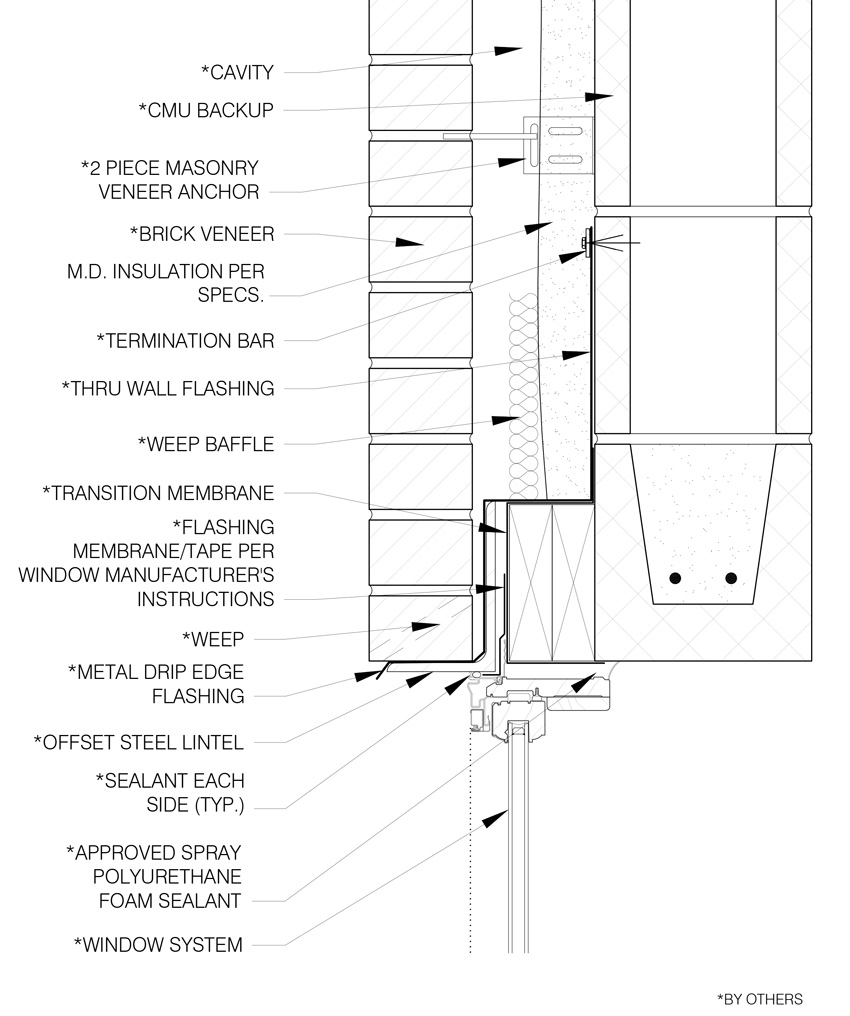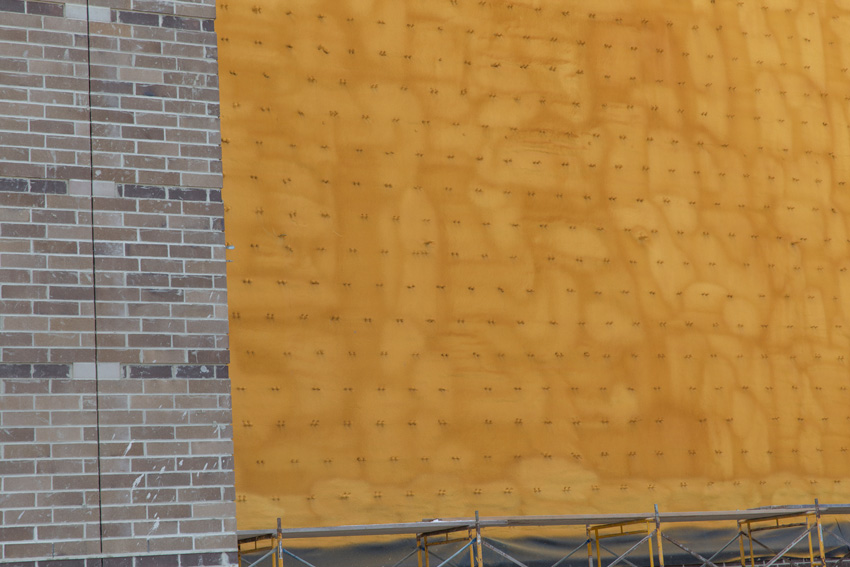Moisture Control with Spray Foam Insulation
Flashing Details
The other important area to address is wall openings, such as windows and doors. Typically, flashing of some sort is required around these openings to assure that water doesn’t penetrate behind the window or door frame. Integration of medium-density spray foam products with flashing membranes is a key component of the water-resistive-barrier system therefore. Fortunately, it is easy to find flashing that is compatible with spray foam insulation. Further, in order to become a certified installer, many spray foam insulation contractors are required to receive training in applying both flashing and spray foam successfully in the field. In addition, some manufacturers have tested the compatibility of self-adhering and liquid-applied membrane products with their medium-density, closed-cell spray foam products and can advise design professionals on compatibility.

Details above windows and doors need to rely on integrated flashing to direct water out of the wall assembly and avoid potential damage.
Other Considerations
It is certainly possible to provide continuous insulation in exterior walls using extruded polystyrene (XPS) or other rigid insulation board products. However, those may require a separate water-resistant barrier, which may or may not double as an air barrier and may create a vapor barrier where one is not needed. Further, they typically require transitional materials at all openings that may or may not be easy to integrate with the board type of insulation.
The choice of cladding may influence the choice of insulation/WRB behind it as well. Brick and masonry veneer walls in particular are known to require careful attention to water drainage and flashing. Failure to do so in design and construction can lead to degradation and even failure of the masonry, particularly in locations where freezing temperatures are common. Stone veneer has the same concerns, particularly if the stone is very porous. Other cladding systems may have more or less porosity as a material, but their seams and joints remain a point of concern. In general, the safest route to take is to be sure that the WRB is foolproof to install, complete in its ability to seal, and continuous across all exterior wall features.
Air Sealing
In addition to sealing out water and moisture, medium-density spray foam products also have the benefit of creating a continuous air-barrier layer in one product. This means that outdoor air seeping past the cladding system will come against a barrier, preventing it from moving further within the wall. This is quite significant since unwanted air infiltration is as important as thermal resistance, if not more so, in determining the energy efficiency of the wall. Energy codes have recognized this phenomenon and now contain mandatory provisions to properly address air sealing of wall assemblies.
Testing of Air Barriers
Recognizing a need to properly define and understand the technical aspects of effective air barriers, the ABAA has become the resource for the design and construction industry on this topic. It points out that an air-barrier system is a combination of building components within the building enclosure— designed, installed, and integrated in such a manner as to stop the uncontrolled flow of air into and out of the building enclosure. It further indicates that effective air barriers have positive impacts not only on heating and cooling costs, but also on moisture problems, indoor air quality, and acoustics. That is because moving air can carry unwanted moisture, contaminants, or noise into a building. Overall, proper air sealing with an air-barrier system results in more sustainable and durable buildings that address numerous green design issues.
ABAA also tests air-barrier materials, which it defines based on a tested air-permeance value. To be a qualifying air-barrier material, the air permeance must be equal to or less than 0.004 cubic feet of air per minute per square foot of material when tested at an air pressure of 1.57 pounds per square foot. The testing basis for this qualification is ASTM E2178: Standard Test Method for Air Permeance of Building Materials. Most foam insulation, particularly if it is closed cell, qualifies as an air-barrier material. Keep in mind, of course, that this test determines the amount of air permeance that migrates through tested materials. It does not address field conditions of holes or gaps in the material. Therefore, ABAA also conducts tests to determine what qualifies as a full air-barrier assembly based on ASTM E2357: Standard Test Method for Determining Air Leakage of Air Barrier Assemblies. In this case, it is not just a single product, but the total air-barrier system (i.e., material, attachment method, joint/seam treatment, etc.) that must demonstrate performance as a continuous air barrier. Further, under this test, it must also perform as a liquid drainage plane (i.e., WRB), accommodate movements of building materials, and provide connections to adjacent materials to prevent air leakage at all critical locations. In short, this second test tries to replicate fully installed conditions.

Large areas of exterior walls can be covered with a continuous, joint-free layer of spray foam insulation.
Among the many rigid foam insulation boards that exist in the marketplace, only four have currently received the ABAA air-barrier-assembly designation. However, in order to qualify, these products typically require sealants or tape to be applied at all joints and penetrations, which can be a very labor-intensive process. Furthermore, the sealing tends to get applied on the exterior, which is the most challenging location in terms of temperature and humidity changes, not to mention quality control of the work being performed. By contrast, virtually all medium-density spray foam products that have been tested have been found to be air impermeable. The thickness where this characteristic is achieved is typically 1.5 inches or less depending on the specific product used. For an exterior continuous insulation application, medium-density spray foam products have the advantage of creating a continuous insulation layer, a water-resistant barrier, plus an air-barrier layer all in one step. With no joints to tape or seal, airtight performance becomes much easier to deliver. This is notably true around wall penetrations for mechanical, electrical, plumbing, or other components that are traditional weak points among conventional air barriers. The one-step application process can also generate cost and construction schedule savings compared to the multiple steps of taping, sealing, and filling encountered with other systems.
Material Compatibility
Part of the testing for a full air-barrier assembly requires manufacturers to prove that materials are chemically and adhesively compatible with adjacent materials proposed for use. Those adjacent materials include flashings and membranes commonly found at wall openings, such as windows and doors, or at wall transitions, such as the base of a masonry wall with weep holes. As a result, the transition materials/membranes that are compatible with a particular spray foam manufacturer are also commonly identified by that manufacturer, although they may be made by others. Collectively, the proper use and detailing of spray foam insulation with appropriate transition membranes creates a complete, effective, and durable air-barrier system. Construction details have been developed by manufacturers to guide architects on how to best accomplish the air-barrier assembly using spray foam products.









